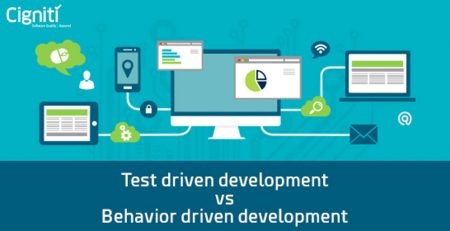Here are the Top Factors for Implementing Continuous Testing Environments!
The launch of iPhone8 is buzzing all across tech and news portals, with updates about how it can entice the users with its fresh features. While this has just begun, techies are already speaking about creating apps for iPhone 11. Likewise, other brands in the same category are gearing up for the launch with new features and value propositions for the user. Continuous Testing and Continuous Delivery is the norm of the day to respond effectively to the market and consumer dynamics. It enables organizations to respond faster and with complete confidence. The role of Continuous Testing is critical in the DevOps environment, as it enables teams to cut down the turnaround time and ensure quality.
DevOps as a concept emphasizes on communication, collaboration, and seamless integration of diverse functions in the software development lifecycle. The idea is to make development, QA, and operations to work together and deliver as per set objectives. Continuous Integration and Continuous Delivery are integral in the DevOps approach. Along these lines, the team is able to go ahead with Continuous Deployment and enable instant updates to the application/software.
Why is Continuous Testing Important for DevOps?
It is a tremendous challenge to implement large scale application suites and with the speed requirements, it needs scrupulous testing at every level. Testing complex systems and tapping on the time pressures is a critical task for every team. Teams need to be equally vigilant to bring in QA and ensure that the outcome is as expected and is ready to deliver anytime during the development cycle.
DevOps and Continuous Testing puts together testing and Quality Assurance with the Dev and Ops processes and optimizes the efforts to attain the business and development goals. In a way, QA is integrated within the overall development cycle, enabling seamless delivery and integration. As applications get complex, it is important for enterprises to build a robust integration model.
Continuous Testing keeps a constant check on Continuous Delivery and Integration.
The only possible way to function effectively in a taxing business environment is to introduce testing right from the inception of the project. The objective of taking the DevOps approach is to not only bring agility, but also make testing an inseparable element of the development cycle. It is impossible for DevOps to operate and get implemented successfully without Continuous Testing, eventually, achieve the business goals.
DevOps cannot be separated from Continuous Testing, as it offers software development leaders the much-needed support for software development to strike a potent balance between quality and speed. Automation/Test Automation is definitely an enabler to effectively implement Continuous Testing and meet the defined objectives.
[Tweet “For #ContinuousTesting, ensure agility in the development and testing process. #SoftwareTesting”]
What are the key drivers for Considering Continuous Testing?
The recent years have instilled a massive change in the way applications are being designed and developed, which has further intensified the complexity of testing and its impact on the business objectives. The question prevails, how can businesses and development teams keep constant track of the modern application delivery cycle and trends pertaining to Cloud, Microservices, and APIs? Effectively, out here, the role of DevOps and Continuous Testing comes into play.
While the strengths are evident, there are some key drivers and compelling reasons for adopting Continuous Testing. The underlying and evident reason is to ensure quality and velocity in this competitive user environment. While we say so, these are some key drivers:
- Rising need to develop and deploy cloud-based applications
- Increasing requirement for parallel deployment across diverse platforms
- Evolution of complex IT infrastructure with a combination of physical systems as well as virtualized environment
- Growing need for automation and continuous Quality monitoring
- Need for standardized processes, templates, guidelines and checklists for DevOps
- DevOps and Continuous Testing cannot be successfully implemented without a strategy and by bringing in the much-needed aspects that will make the process effective and measurable.
Key factors to make Continuous Testing much more effective
[Tweet “What are the key factors for implementing #ContinuousTesting? #SoftwareTesting #TestAutomation”]
1.Collate the required business requirements
Any new approach or concept in software/application development is adopted to enable the process and make it more efficient. Ultimately, it has to be in sync with the business objectives. The idea of Continuous Testing is to push testing way ahead in the development cycle, so in a way test early and test frequently. However, it is important to collate the required details about the business objectives before the development process begins.
This basically implies that the QA must work in close quarters with business analysts, which will enable the teams to eliminate any amount of ambiguity by referring to relevant user stories. It is equally important to constantly refer to user stories and information collated from application usage.
2. Ensure agility in the development and testing process
Continuous Testing cannot be operational in a traditional development model. The environment has to be much more flexible for implementing the practices. Mostly importantly, the ideology has to be in sync with the business values and objectives. So, in spite of focusing energies on developing testing artefacts, the emphasis has to be on organizing the pattern of testing.
Particularly, the teams need to follow lean pattern of testing and development, where the testers are paired with the developers to ensure effective unit testing. Likewise, the teams should avoid extensive test cases and test plans to cut down on any delay in testing the code. At the same time, an investigative approach should be followed in the testing approaches, where manual testing can be combined with automated testing.
3. Involve sufficient QA practices
While defining the Continuous Testing strategy, it is important to integrate it with effective QA and testing practices. It will help drive development and define a comprehensive agile QA testing strategy. Likewise, it can be helpful to organize regular QA workshops for testers, where they can enhance their overall skill-sets.
Moreover, the overall QA approach can be leveraged to build a robust technical architecture, develop better applications, established defined processes and guidelines, and adequately implement testing techniques for seamless software/application development.
In Conclusion
Gartner estimates that “By 2020, DevOps initiatives will cause 50% of enterprises to implement continuous testing using frameworks and open-source tools.” Continuous Testing has been an enabler throughout for enterprises, but it is equally important to incorporate the right approach and the required factors to make it work for your organization.
[Tweet ““By 2020, DevOps initiatives will cause 50% of enterprises to implement #continuoustesting using frameworks and open-source tools.”@Gartner_inc “]
At Cigniti, we standardize efforts and ensure accelerated time to market with DevOps Testing. Cigniti’s CI testing experts boast of a rich experience in Continuous Integration testing and can configure and execute popular CI tools.
Connect with us to build a market-relevant DevOps strategy for your enterprise.





Leave a Reply